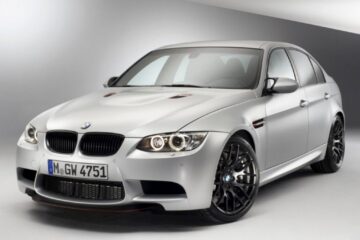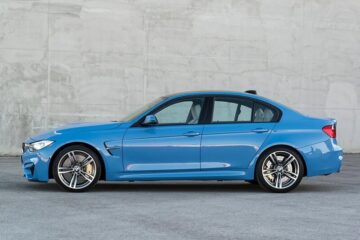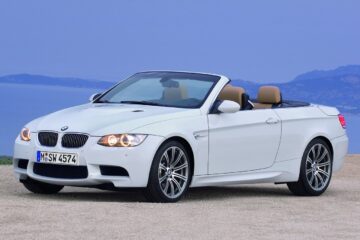October 2000 was marked by the presentation of a new generation of the legendary car model BMW M3 E46, which was equipped with a new power unit with six cylinders and had 3.2 liters of displacement. This generation was designed to replace the E36 in cabriolet and coupe bodies of the M3 lineup.
The first versions of the M3 range were painted in only one tone – Laguna Seca Blue. The exterior differences from the standard models of the third series mainly consisted in large extensions of the wheel arches and a bulge on the hood lid, made of aluminum (this bulge was called “Power Dome”). Also immediately striking were the side mirrors, which had more optimized aerodynamic shapes, as well as side wings equipped with “gills”. The muscular front bumper also caught the eye. It was hard to leave out the massive rear bumper equipped with four exhaust pipes and forged 19-inch wheels.
Appearance
There are cases when people confuse ordinary cars of the third series from the Bavarians with M versions, despite the presence of certain distinctive features. The first thing that immediately focuses attention is the increased aggressiveness, which the standard modification does not differ in any way. The dodger of BMW M3 E46 is also very striking.
The front part mesmerizes the users’ eyes with a massive hood, which hides the powerful motor from prying eyes. In the regular modification, unlike the sporty version, there are no air intakes either. The front bumper has received more shapely and massive outlines. In this detail there is no place for fog lights, but there are three large air intakes. Head optics is made in the classic for Germans style – it is rectangular. Turn signal repeaters are located on the wings, and there is a plastic insert in the lower part of the headlights. In the space between the headlights there is a legendary radiator grille with recognizable “nostrils”.
The side of the M3 E46 has a sporty appearance. The wheel arches immediately catch the eye thanks to their large extensions. The rear part of the fenders has air intakes decorated with the M3 trademark. In the aggressive style is made and the sill of the car, as well as plastic covers. Together with streamlined side mirrors, it creates a swift appearance of the car. As an addition, 18 or 19-inch forged wheels are used.
If you look at the rear of the car, confusion with the standard model may arise even for fans of the company. Distinctive features can be noticed only in a small spoiler located on the massive trunk lid, as well as twin exhaust pipes. The taillights are the same as on the regular model. They consist of two parts, thanks to which they are successfully placed on the fender and trunk lid.
BMW M3 E46 was presented to buyers with different body types, so the dimensions of the car depended on the body design. Dimensions of BMW E46 M3 in sedan body provided length of 4492 millimeters with a width of 1780 millimeters, while the height was 1372 millimeters. The wheelbase was 2,731 millimeters. The ground clearance was typical for sports cars and was 110 millimeters. Curb weight of the coupe was equal to 1.5 tons.
M3 E46 in cabriolet bodywork is distinguished by slightly different dimensions: the length of the car is 4488 millimeters, with a width of 1757 millimeters and height of 1370 millimeters, with a wheelbase stretched by 2725 millimeters. The ground clearance of this body does not differ from the sedan and is 110 millimeters. The curb weight of the convertible is a bit more – 1660 kilograms.
There is also a difference in the usable volume of the luggage compartment, because the soft-top roof of the convertible has to be hidden somewhere, so some volume is taken up by it. For this version of the body is characterized by a luggage compartment size of three hundred liters, and in the trunk of the coupe body fits 410 liters of cargo. The volume of the gas tank does not depend on the body version and puts in itself 63 liters of fuel.
An important difference between the M3 E46 and the standard model is the range of colors, which provides a wide choice. Especially fastidious buyers had the opportunity to choose individual body color. BMW M3 coupe E46 was not produced.
Interior
On the photo of BMW M3 E46 it is noticeable that the differences from the standard modification in the exterior appearance is difficult not to notice, but in the interior space such changes are practically not visible. Execution of the interior is made in the classic style for the German company. The upper part of the front panel has a pair of air ducts, from the bottom of which there is a display of multimedia system of small size. The climate control unit is also located there. A little to the side is an additional set of switches that allow you to control door locking, seat heating and other additional functions.
The central tunnel dividing the space between driver and passenger houses the gearbox selector in its front part, which bears the “M” marking. On both sides of the gearbox lever there are buttons for controlling the electric window lifters. The tunnel then gradually flows into a comfortable armrest with a cutout for the parking brake lever.
The most noticeable differences were made to the dashboard. The interior of BMW M3 E46 was distinguished by the fact that it has a different graduation, which is executed in a slightly different design. Modernization is also noticeable on the steering wheel. The differences are manifested in the nameplate “M”, located at the very bottom of the steering wheel. The steering wheel itself is executed in a classic for Bavarians three-spoke form. On two spokes there are buttons that allow you to control additional systems of the car. In the cabriolet body, produced since 2001, one could find paddles under the steering wheel, responsible for gear shifting.
Materials used for interior trim were of the highest quality and class as always. For the most part natural leather was used, but it was possible to find elements with suede and plastic. Seats were equipped with electric adjustment, and are characterized by a sporty fit and lateral support, which is very pronounced. The rear row of seats can easily accommodate two passengers, but it is possible to place there and the third, but you will have to squeeze.
Various exclusive colors were also used for the interior trim, which could be combined with each other depending on the buyers’ choice.
Motors
The release of the BMW M3 E46 model brought to the German concern the decision to abandon the previous engines and the introduction of two motors that are radically different from one another. The most powerful version of the E46 involved replacing the old S52 engine and the S50B32 motor with the S54 powertrain. This internal combustion engine was the top of the M54 lineup, which also included other models that made the BMW M3 E46 perform well.
The car was equipped with an atmospheric gasoline power unit, providing for the installation of six cylinders. The working volume of this motor was 3.2 liters. Technical characteristics of the BMW M3 E46 were as follows: the maximum power developed by this engine variant reached 343 horsepower, and the peak torque reached 365 Nm.
A limited edition of the BMW M3 CSL E46 was also available, which was fitted with a 360-horsepower motor capable of delivering 370 Nm of maximum torque. A six-speed manual gearbox was chosen as a pair to work with, and an automatic was also installed. Traction from the motor, as on all previous generations, was transferred to the rear axle.
The first hundred kilometers per hour, the car gained only 4.9 seconds, which at that time was quite a high indicator, which was rarely surpassed by anyone. The maximum speed of the car was 250 kilometers per hour, although this threshold was set by electronics, and the actual capabilities of the motor allowed to accelerate it to 290 kilometers per hour.
The new S54 inline six-cylinder engine was developed on the basis of the S50B32 engine, European classification. The cylinder block, made of cast iron, was slightly improved by increasing the cylinder diameters to 87 millimeters. Inside the block was a crankshaft operating with 12 counterweights. The connecting rods were forged and reinforced, and their length was 13.9 centimeters. New pistons were also installed, capable of achieving a compression ratio of 11.5. The piston system was cooled by oil injectors.
The cylinder head also underwent some modernization. The engine began to use a modified Double-VANOS system, which allowed for a continuous change in the camshaft timing. Also installed were modified hollow camshafts made of cast iron. The weight of the cylinder head itself was reduced.
The new version of the engine has the same valves as on the predecessor S50B32, installed on the previous generation M3. There are no hydraulic compensators on the motor, so it is necessary to adjust thermal clearances on the valves with washers after every 50 thousand kilometers.
The intake included the installation of individual throttle valves for each cylinder. Responsible for everything was the Siemens MSS 54 electronic engine control unit, which tolerates software changes quite well.
For the BMW E46 M3 CSL version, which was weight-reduced and produced in a limited edition in 2004, a top-end modification of the BMW M3 E46 engine was developed. This engine differs from the standard motor for the European market by installing a new intake system, aggressive camshafts, and new valves. A lighter exhaust system was also installed. This made it possible to increase the motor’s output to 360 horsepower without the need for additional superchargers. The engine was designated the S54B32HP.
The S version of the engine differed from the usual M54 engine in the absence of global problems with increased oil consumption. But if this malfunction occurred, it is worth paying attention to the oil caps. In case when oil consumption is prohibitive, it is necessary to check the rings.
The incidence of overheating was also reduced, although it could occur from time to time. In most cases, the cause of the malfunction was air plugs in the cooling system, dirty radiator, failed pump, broken thermostat or radiator cap.
The motor resource is quite large and it is able to provide not one hundred kilometers of smooth operation, but you should not forget about the manner of driving the M3. In most cases, on the secondary market you can find only dead engines, which could present a lot of surprises at any time. On average, with aggressive operation, which is characteristic of the car M3 E64, the power unit is able to drive up to 150 thousand kilometers. After this period, it was necessary to replace the liners and timing chain together with tensioners.
But such problems could only affect motors manufactured before 2003. The latest versions manufactured after this date are free of such problems. The power unit requires the use of only quality oil, the replacement dates of which must be observed. Maintenance and constant condition control are also a guarantee of good performance.
Despite all the power and dynamics, the BMW M3 E46 was not distinguished by rather large fuel consumption. Consumption per hundred kilometers in the urban cycle was only about 17 liters, and when driving on the highway per 100 kilometers consumption was only 8.5 liters.
Modifications
In early 2001, the world saw the BMW M3 GTR racing coupe, which was based on the E46. This car was equipped with an eight-cylinder engine in V configuration, which provided 4 liters of working volume. The characteristics of the BMW M3 GTR E46 were as follows: its maximum power reached 500 horsepower. A total of 16 examples were produced for the American Le Mans Series (ALMS). The BMW M3 GTR E46 looked much more attractive in person.
When the 2001 racing season was over, the Bavarians released another limited edition of 10 models for transportation on public roads. The price of the model was 250 thousand euros. Also the modification of BMW M3 GTR E46 became famous thanks to the game most wanted.
This car is immediately noticeable that it was designed not for public use. The body is characterized by large extensions of wheel arches, installation of more massive bumpers, another hood with large holes for ventilation. The rear end was equipped with a huge spoiler placed on the trunk lid. The interior was equipped with a safety cage and buckets instead of the usual seats.
In 2004, the world was also presented a limited version of CSL, based on the M3 E46. The total circulation of the modification amounted to 1400 copies. For this car was characterized by only two variants of body color: black Black Sapphire Metallic or silver Silver Grey Metallic.
Changes were made to the base engine installed in the M3 E46, which increased its power to 360 horsepower. The engine was paired with a robotized gearbox.
Among other changes, the car’s suspension and steering have also been reconfigured. Reinforced brakes have been introduced. The main efforts of engineers were concentrated on reducing the weight of the car. Thanks to the overall work, it was possible to achieve a weight of 1385 kilograms, which is 115 kilograms less than in the base model.
Differences between restyling and prerestyling
In 2003, the model was slightly updated. First of all, the changes included installation of rear lights with adaptive LED optics. The control panel of the automatic climate control system also appeared. Several additional body paint options were added to the color range. The Assist system began to be introduced in the model, as well as Bluetooth wireless communication channel.
The year 2004 also saw a minor restyling, which brought a second update to the 2005 BMW M3 E46 color scheme, as well as revised suspension settings. The tuning changes were made to reduce the car’s understeer and provide better handling at high speeds.
Generations and equipment
Coupe 3rd generation
10.2000 – 12.2006
| 3.2 MT | S54B32 | 3.2L | 343 hp |
Convertible 3rd generation
01.2001 – 11.2006
| 3.2 MT | S54B32 | 3.2L | 343 hp |
| 3.2 AMT | S54B32 | 3.2L | 343 hp |
Coupe 3rd generation
10.2000 – 12.2006
| 3.2 MT | S54B32 | 3.2L | 343 hp |
| 3.2 AMT | S54B32 | 3.2L | 343 hp |
| 3.2 AMT CSL | S54B32HP | 3.2L | 360 hp |



0 Comments